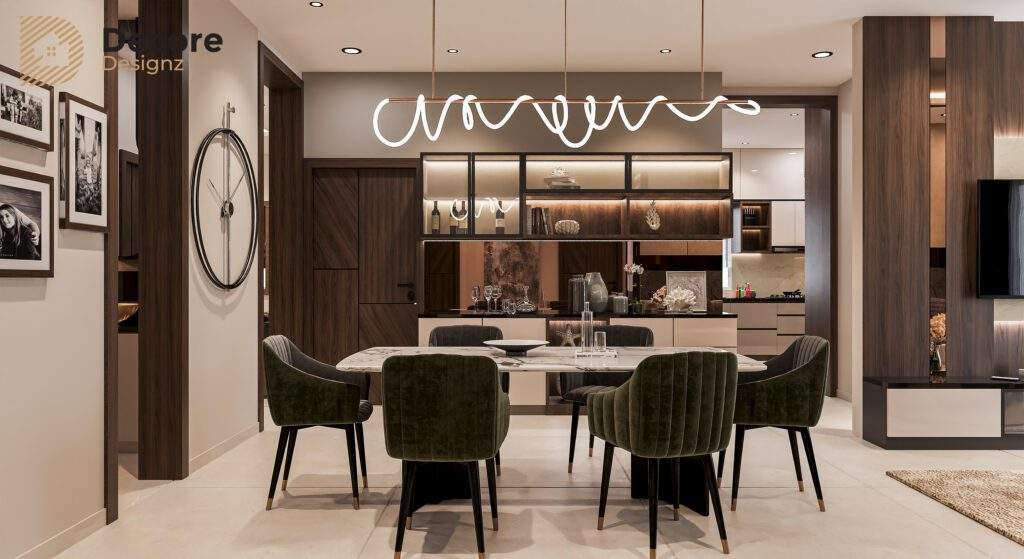The Ultimate Guide to Dining Room Lighting

The Ultimate Guide to Dining Room Lighting
Lighting plays a crucial role in creating the perfect dining room ambiance. Dining room lighting not only enhances the room’s aesthetic appeal but also sets the mood for gatherings, whether for casual family meals or formal dinner parties. This guide explores different types of dining room lighting, how to choose the right fixtures, and tips for creating a warm, inviting atmosphere.
Understanding Dining Room Lighting Basics
Types of Dining Room Lighting
- Ambient Lighting: Provides overall illumination and ensures the room is well-lit. Common options include chandeliers, ceiling-mounted fixtures, and recessed lights.
- Task Lighting: Focuses light on specific areas like the dining table or buffet. Pendant lights and track lighting are popular choices for dining room lighting.
- Accent Lighting: Highlights architectural features, artwork, or other focal points in the dining room. Wall sconces, under-cabinet lights, and spotlights are typical accent lighting fixtures.
Layering Your Dining Room Lighting
Combining ambient, task, and accent lighting creates a layered effect that adds depth and dimension to your dining room. A well-lit dining room uses ambient lighting for general illumination, task lighting for functionality, and accent lighting to enhance visual interest.
Choosing the Right Fixtures for Dining Room Lighting
Chandeliers for Dining Room Lighting
Chandeliers are classic dining room lighting fixtures that can serve as stunning focal points. When selecting a chandelier:
- Ensure it’s proportionate to your dining table and room size.
- The bottom of the chandelier should hang 30-36 inches above the table for a standard 8-foot ceiling, adjusting for higher ceilings.
- Consider the style and finish to match your dining room decor.
Pendant Lights for Dining Room Lighting
Pendant lights offer a versatile and stylish option, especially for modern and contemporary dining rooms. They can be hung individually or in a series:
- Over a rectangular table, consider a series of pendants.
- Over a round table, a single, larger pendant light works well.
- Ensure pendants hang at a height that provides sufficient light without obstructing views.
Recessed Lighting for Dining Room Lighting
Recessed lights provide unobtrusive ambient lighting and are ideal for a clean, modern look:
- Space them evenly across the ceiling.
- Use dimmable bulbs to adjust the lighting intensity for different occasions.
Wall Sconces for Dining Room Lighting
Wall sconces add accent lighting and can highlight architectural features or artwork:
- Position them at eye level to avoid glare.
- Pair them symmetrically on either side of a focal point like a buffet or artwork.
Floor and Table Lamps for Dining Room Lighting
While not as common in dining rooms, floor and table lamps can add extra light and create a cozy atmosphere:
- Place a floor lamp in a corner to cast a warm glow.
- Use table lamps on sideboards or buffets for additional task lighting.
Selecting Bulbs and Color Temperature for Dining Room Lighting
Types of Bulbs for Dining Room Lighting
- Incandescent Bulbs: Provide a warm, inviting glow but are less energy-efficient.
- LED Bulbs: Energy-efficient and long-lasting, available in various color temperatures.
- CFL Bulbs: More energy-efficient than incandescent bulbs but take time to warm up.
Color Temperature for Dining Room Lighting
Color temperature affects the mood of your dining room:
- Warm White (2700K-3000K): Creates a cozy, intimate atmosphere.
- Cool White (3500K-4100K): Offers a brighter, more energetic feel, suitable for modern spaces.
- Daylight (5000K-6500K): Mimics natural daylight but can be too harsh for dining rooms.
Dimmable Options for Dining Room Lighting
Using dimmable bulbs and fixtures allows you to adjust the light intensity based on the occasion:
- Bright light for cleaning or homework.
- Soft, dim light for intimate dinners.
Tips for Effective Dining Room Lighting
- Layer Your Lighting: Combine ambient, task, and accent lighting for a balanced and functional space.
- Use Dimmers: Install dimmer switches to control the mood and brightness of your dining room lighting.
- Consider Light Placement: Avoid placing lights directly over seating areas to prevent glare.
- Highlight Focal Points: Use accent lighting to draw attention to artwork, architectural features, or decorative pieces.
Conclusion
The right dining room lighting can transform your space into a welcoming and stylish area. By understanding the different types of dining room lighting and how to layer them, you can create a functional and aesthetically pleasing environment for any occasion. Choose fixtures that complement your decor, select appropriate bulbs, and use dimmers to adjust the ambiance as needed. With these tips, you’ll be well on your way to designing the perfect dining room lighting scheme.
